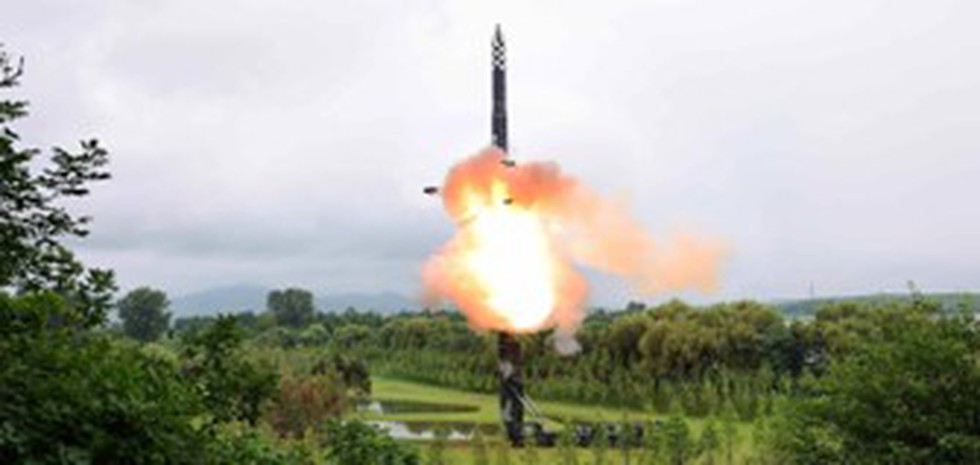
About Hwasong-18:
- It is a type of solid-fuel intercontinental ballistic missile (ICBM) developed by North Korea.
- It is North Korea's first ICBM to use solid-fuel, which allows for faster launches.
Solid Fuel vs Liquid Fuel Missiles:
- Liquid propellants provide greater propulsive thrust and power, but require more complex technology and extra weight.
- Solid fuel is dense and burns quite quickly, generating thrust over a short time.
- Solid fuel can remain in storage for an extended period without degrading or breaking down - a common issue with liquid fuel.
- Solid-fuel missiles are easier and safer to operate, and require less logistical support, making them harder to detect and more survivable than liquid-fuel weapons.
What is a Ballistic Missile?
- It is a rocket-propelled self-guided strategic-weapons system that follows a ballistic trajectory to deliver a payload from its launch site to a predetermined target.
- Ballistic missiles are powered initially by a rocket or series of rockets in stages, but then follow an unpowered trajectory that arches upwards before descending to reach its intended target.
- Ballistic missiles can carry either nuclear or conventional warheads.
- What is an ICBM? An ICBM, is a long-range (greater than 5,500 km or 3,500 miles) ballistic missile typically designed for nuclear weapons delivery, that is, delivering one or more nuclear warheads.
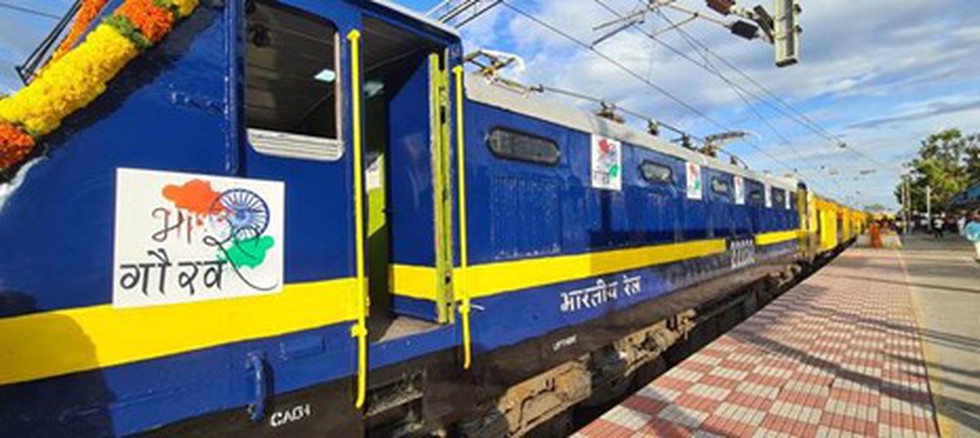
About Amrit Bharat Station Scheme (ABSS):
- It envisages development of stations on a continuous basis with a long-term vision.
- The scheme will subsume all previous redevelopment projects where work is yet to begin.
- The scheme aims at preparation of Master Plans of the Railway stations and implementation of the Master Plan in phases to enhance the facilities including and beyond the Minimum Essential Amenities.
- However, plans and consequent budgets will only be approved on the basis of factors such as footfall and inputs from stakeholders.
- Zonal railways have been given the responsibility of selecting stations, which will then be approved by a committee of senior railway officials.
- The model envisages low-cost redevelopment of stations which can be executed timely.
- The scheme shall cater for introduction of new amenities as well as upgradation and replacement of existing amenities.
- Facilities Planned under Amrit Bharat Station Scheme:
- Provision for Roof Plaza to be created in future.
- Free Wi-Fi, space for 5G mobile towers.
- Smooth access by widening of roads, removal of unwanted structures, properly designed signages, dedicated pedestrian pathways, well planned parking areas, improved lighting etc.
- Attempts shall be made to club different grades/types of waiting halls and provide good cafeteria/retail facilities as far as possible.
- Better furniture will be installed in waiting rooms, platforms, rest rooms and offices.
- High level platforms(760-840 mill meter) shall be provided at all categories of stations.
- Special amenities for the disabled as per guidelines issued by the Railway Board from time to time.

About Bard Chatbot:
- It is an Artificial Intelligence (AI) chatbot developed by Alphabet, parent company of Google.
- It is an example of generative AI that can respond to questions in a human-like way.
- Features:
- Users can interact with the Bard chatbot in 40 languages, including nine Indian languages.
- Users can change the tone and style of Bard's responses to either simple, long, short, professional or casual.
- They can pin or rename conversations, export code to more places and use images in prompts.
What is Generative AI?
- Generative AI (GenAI) is a type of AI that can create a wide variety of data, such as images, videos, audio, text, and 3D models.
- It does this by learning patterns from existing data, then using this knowledge to generate new and unique outputs.
- GenAI is capable of producing highly realistic and complex content that mimics human creativity, making it a valuable tool for many industries such as gaming, entertainment, and product design.
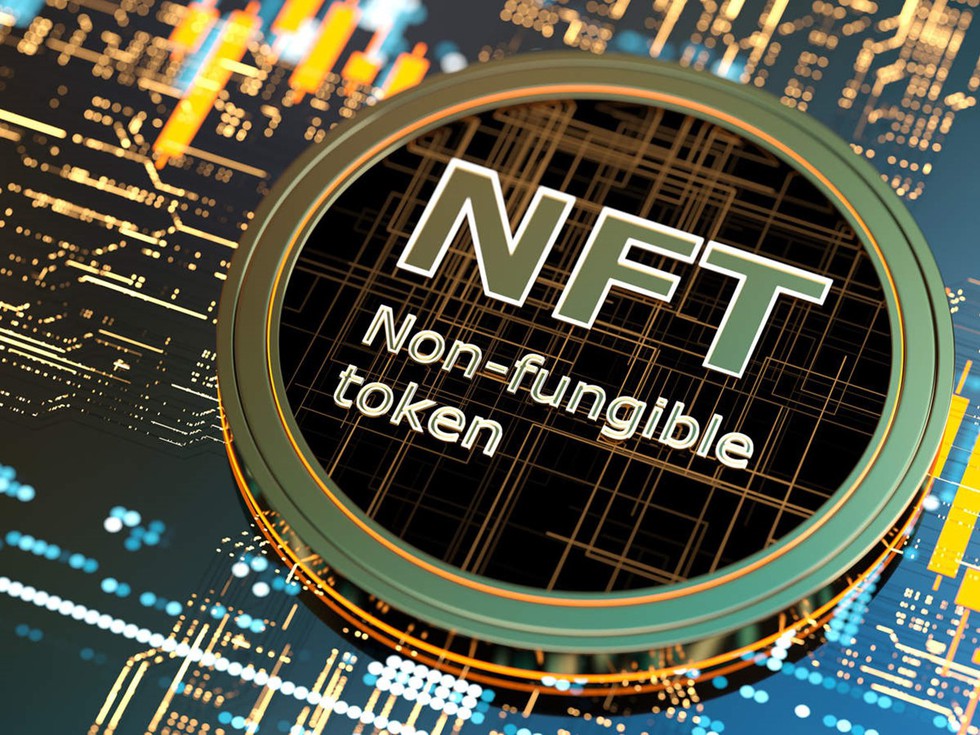
About Non-Fungible Tokens (NFTs):
- NFTs are unique cryptographic tokens that exist on a blockchain and cannot be replicated.
- They can represent digital or real-world items like artwork, photograph, song, video, real estate, individuals' identities, property rights, and more.
- Thus, NFTs are assets that have been tokenized via a blockchain. They are assigned unique identification codes and metadata that distinguish them from other tokens.
- The term ‘non-fungible’ simply means that each token is different as opposed to a fungible currency such as money (a ten-rupee note can be exchanged for another and so on).
- NFTs can be traded and exchanged for money, cryptocurrencies, or other NFTs—it all depends on the value the market and owners have placed on them.
- NFT transactions are recorded on blockchains, which is a digital public ledger, with most NFTs being a part of the Ethereum blockchain.
- NFTs became popular in 2021, when they were beginning to be seen by artists as a convenient way to monetise their work.
What is Blockchain Technology?
- A blockchain is essentially a digital ledger of transactions that is duplicated and distributed across the entire network of computer systems on the blockchain.
- Each block in the chain contains a number of transactions, and every time a new transaction occurs on the blockchain, a record of that transaction is added to every participant’s ledger.
- Decentralized blockchains are immutable, which means that the data entered is irreversible.
- This means if one block in one chain was changed, it would be immediately apparent it had been tampered with.
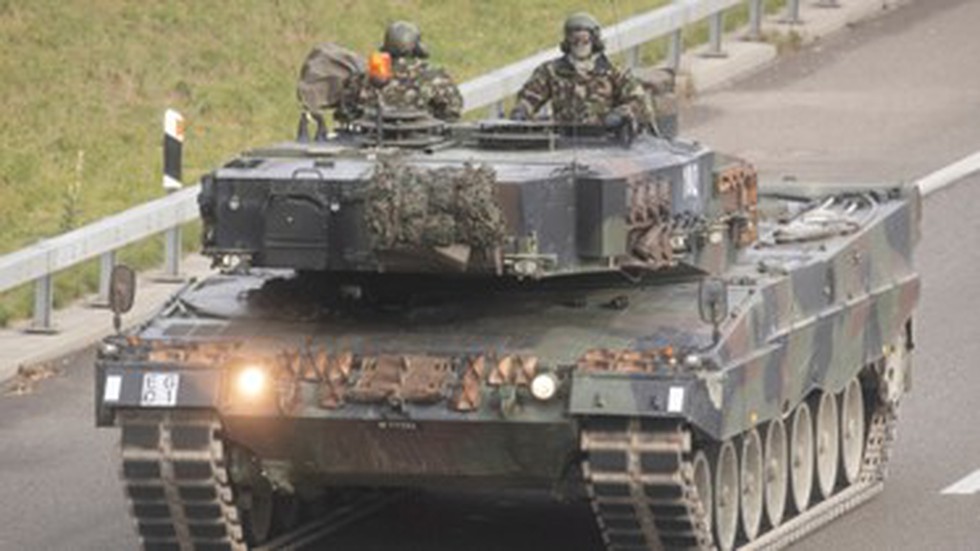
About Leopard 2 battle tank:
- It is a German made main battle tank.
- Manufacturer: Developed by German weapons manufacturer Krauss-Maffei Wegmann (KMW).
- Leopard was first produced in the late 1990s for the West German army in response to Soviet threats during the Cold War.
- The Leopard 2 tanks are mainly used by the German military. More than a dozen countries in Europe as well as other countries like Canada are also using these tanks.
- Features:
- It has a crew of four and a range of about 500 kilometres (310 miles).
- Weight: 55 tonnes
- Top speed: 68 km/h (42mph).
- Its main weapon is a 120mm smooth bore gun, and it has a fully-digital fire-control system.
- It is also armed with two coaxial light machine guns.
- They also provide “all-round protection” for troops from threats such as mines, anti-tank fire, and improvised explosive devices

About Atlantic menhaden:
- It is a commercially important Atlantic Ocean fish, also known as Fatback, Bunker, Pogie.
- Habitat: They are found in coastal and estuarine waters from Nova Scotia to northern Florida.
- Diet: They are filter feeders, primarily consuming phytoplankton and zooplankton in the water column.
- The disappearance of most of the menhaden from the bay is contributing to the disappearance of the many species that rely on menhaden.
- Uses of this fish
- They are harvested for use as fertilizers, animal feed, and bait for fisheries including blue crab and lobster.
- They are a major source of omega-3 fatty acids, so they are also used to develop human and animal supplements.
- Conservation status
- IUCN: Least concern
Key facts about the Chesapeake Bay
- It is the largest inlet in the Atlantic Coastal Plain of the eastern United States.
- It was created by the submergence of the lower courses of the Susquehanna River and its tributaries,
- The southern part of the bay is bordered by Virginia and its northern part by Maryland.

What are the key findings?
- Sediment profile dating back to 8000 years which helped decode climatic signatures indicated a relatively reduced rainfall and weak southwest monsoon during the late Holocene (around 2827 years BP).
- The seasonal lake in the Kaas Plateau is probably a product of an erosional localized shallow depression on a pediment (rock debris) developed over the crust.
- During the early to mid-Holocene, at around 8664 years ago, pollen, as well as diatom data, indicated a change in the climate from freshwater to drier conditions with low rainfall.
- Surprisingly, there was a significant rise in the number of diatoms in between.
- This suggests a major shift in the Indian summer Monsoon activity during that time, possibly resulting in intermittent humid periods amidst the dry spells.
- There was a decrease in rainfall and a weakened southwest Monsoon during the late Holocene (around 2827 years BP).
- During the recent past (around last 1000 years), pollen, as well as the presence of a high number of planktonic and pollution-tolerant diatom taxa indicated lake eutrophication, possibly due to human impact and cattle/livestock farming in the catchment.
About Kaas Plateau:
- It is nestled in the Western Ghats is about 140 km from Pune.
- It is part of the Western Ghats which was declared as world natural heritage site by United Nations Educational, Scientific and Cultural Organisation (UNESCO) in 2012
- It is known as Kaas Pathar in Marathi, its name is derived from the Kaasa tree, botanically known as Elaeocarpus glandulosus (rudraksha family).
- It is also known as valley of flowers which is situated at a mighty altitude of 1200 metres.
- It is a major biodiversity hotspot owing to the many varieties of endemic flowers and butterflies that are found here.
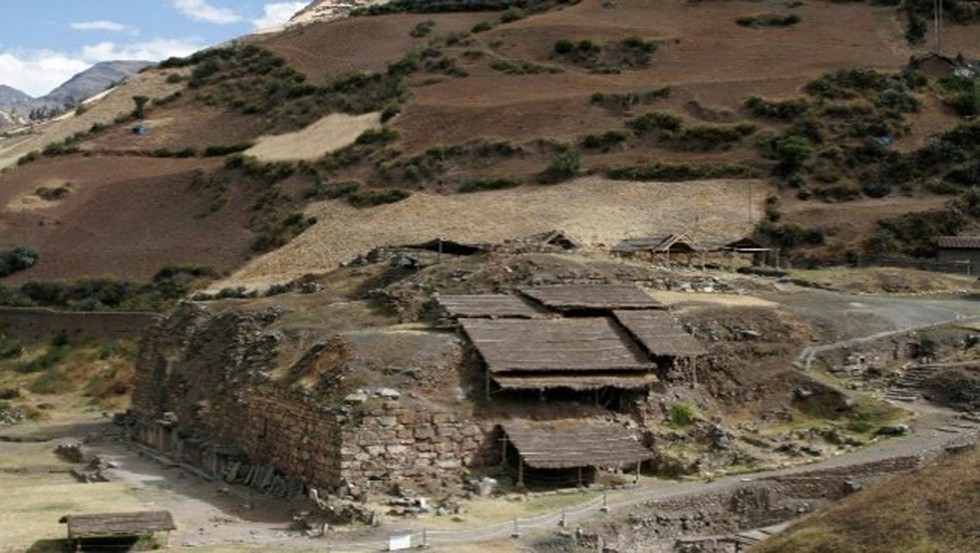
About Chavin de Huantar
- It is Located around 190 miles (306 km) northeast of Lima, Peru.
- The Chavin de Huantar archaeological site is among the culture's most important centres, thriving from around 1,500-550 B.C.
- It is one of the earliest and best-known pre-Columbian sites.
- They date back to the first sedentary farming communities in the northern highlands of the Peruvian Andes, more than 2,000 years before the Inca Empire rose to power.
- It served as the centre of social, political, and religious activity in the Andean Highlands.
- The Chavín people developed a culturally rich society with a complex religious hierarchy and an extensive trade network
- The Chavin are well-known for their advanced art, often featuring depictions of birds and felines.
- It is evident in the still breathtaking stone buildings, terraces and plazas embellished with anthropomorphic and zoomorphic bas-relief carvings.
- It was declared as the UNESCO world heritage site in 1985.
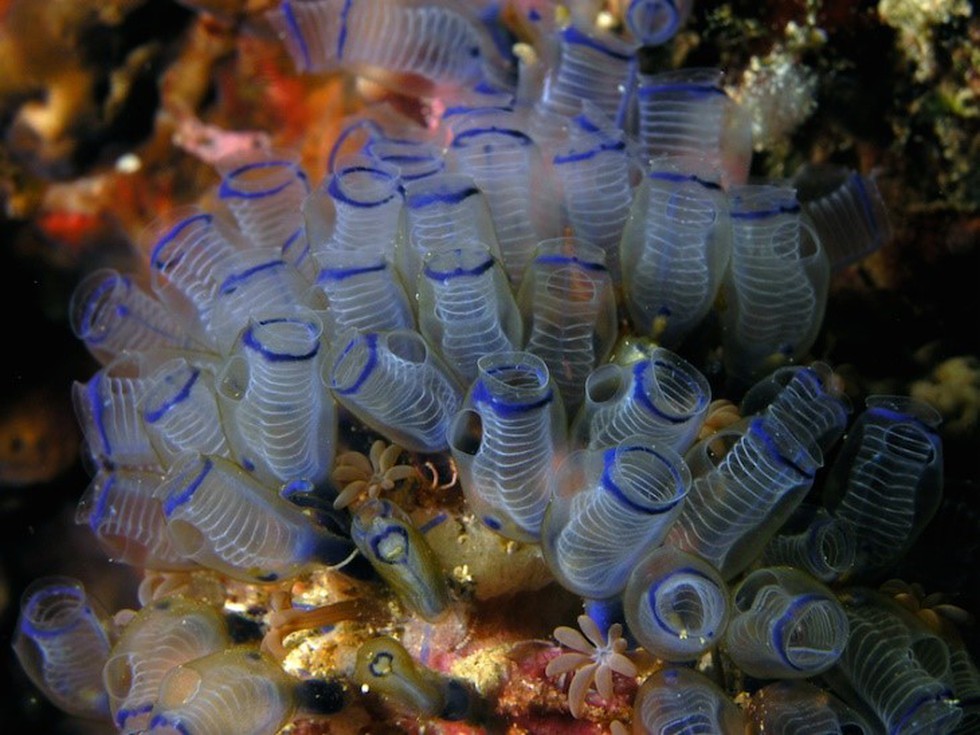
Why in news?
- The new fossil, named Megasiphon thylakos, revealed that ancestral tunicates lived as stationary, filter-feeding adults and likely underwent metamorphosis from a tadpole-like larva.
About Tunicates:
- These are commonly called sea squirts which are a group of marine animals.
- They spend most of their lives attached to docks, rocks or the undersides of boats.
- About 3,000 species of tunicate exist in the world’s oceans, living mostly in shallow water.
- They are a species of marine invertebrates with an evolutionary history from at least 500 million years ago.
- Researchers are interested in them as they are the closest relatives of vertebrates, which includes fish, mammals, and people.
- There are two main tunicate lineages namely;
- Ascidiaceans: They are often called “sea squirts and most ascidiaceans begin their lives looking like a tadpole and mobile, then metamorph into a barrel-shaped adult with two siphons. They live their adult life attached to the seafloor.
- Appendicularias: They retain the look of a tadpole as they grow to adults and swim freely in the upper waters. These seem extremely far removed from vertebrates.
- Features
- Tunicates are truly strange creatures that come in all shapes and sizes and have a wide variety of lifestyles.
- An adult tunicate’s basic shape is typically barrel-like, with two siphons projecting from its body.
- One of the siphons draws in water with food particles through suction, allowing the animal to feed using an internal basket-like filter device.
- The other siphon expels the water.

About BHARAT campaign:
- It is a one month-long Campaign with a target of Rs 7200 crore.
- It aims to get active involvement and support of members of commercial Banks in the public and private sector, Regional Rural Banks, Small Finance Banks, NBFCs and select cooperative Banks in promoting the Scheme of Agriculture Infrastructure Fund.
What is Agriculture Infrastructure Fund?
- It is a Central Sector Scheme which was launched in 2020
- The scheme shall provide a medium - long term debt financing facility for investment in viable projects for post-harvest management Infrastructure and community farming assets through interest subvention and financial support.
- Duration: The duration of the Scheme shall be from FY2020 to FY2032 (10 years).
- Benefits
- All loans under this financing facility will have interest subvention of 3% per annum up to a limit of Rs. 2 crores. This subvention will be available for a maximum period of seven years.
- Further, credit guarantee coverage will be available for eligible borrowers from this financing facility under Credit Guarantee Fund Trust for Micro and Small Enterprises (CGTMSE) scheme for a loan up to Rs. 2 crores. The fee for this coverage will be paid by the Government.
- In case of FPOs the credit guarantee may be availed from the facility created under FPO promotion scheme of Department of Agriculture, Cooperation & Farmers Welfare (DACFW).
- Moratorium for repayment under this financing facility may vary subject to minimum of 6 months and maximum of 2 years.



.png)

























































































































































.png)
.png)
.png)
.png)
.png)


.png)
.png)
.png)





.png)
.png)






.png)
.png)
.png)
.png)
.png)
.png)
.png)
.png)
.png)

.png)







.png)
.png)


.png)
.png)
.png)


.png)

.png)
.png)





.jpg)

.png)
.png)


.png)

.png)
.png)
.png)

.jpg)

.jpg)


.png)

.png)
.png)
.png)
.png)
.png)
.png)
.png)
.png)
.png)
.png)




.png)

.png)



.png)
.png)
.png)
.png)
.png)
.png)
.png)
.png)
.png)
.jpg)
.jpg)

.png)
.png)
.png)
.png)
.png)
.png)
.png)
.png)
.png)
.png)
.png)
.png)
.png)
.png)
.png)
.png)
.png)
.png)
.png)
.png)
.png)
.png)



.png)
.png)

.jpg)
.jpg)


.jpg)
.jpg)
.jpg)
.jpg)
.jpg)

.jpg)








.jpg)
.jpg)
.jpg)
.jpg)
.jpg)

















.jpg)
.jpg)







.jpg)


















.jpg)
.jpg)






























































































.jpg)
.jpg)


























.jpg)

.jpg)










.jpg)








.jpg)




.jpg)










.jpg)


















.jpg)












































.jpg)














.jpg)
.jpg)
.jpg)





.jpg)

.jpg)
.jpg)





































































.jpg)


































.jpg)
.jpg)
















































.jpg)












.jpg)


.jpg)




.jpg)
.jpg)
.jpg)

.jpg)
.jpg)
.jpg)
.jpg)

.jpg)
.jpg)
.jpg)

.jpg)
.jpg)
.jpg)
.jpg)
.jpg)
.jpg)
.jpg)
.jpg)

.jpg)


.jpg)
.jpg)
.jpg)
.jpg)
.jpg)
.jpg)
.jpg)
.jpg)
.jpg)
.jpg)











.jpg)
.jpg)





.jpg)
.jpg)
.jpg)
























.jpg)
























.jpg)









.jpg)
.jpg)







.jpg)
.jpg)









































.jpg)
.jpg)
.jpg)
.jpg)
.jpg)

.jpg)
.jpg)
.jpg)
.jpg)
.jpg)


.jpg)
.jpg)
.jpg)
.jpg)
.jpg)

.jpg)
.jpg)
.jpg)
.jpg)
.jpg)
.jpg)
.jpg)
.jpg)
.jpg)
.jpg)
.png)

.png)
.png)

.png)
.png)
.png)
.png)


.jpg)
.jpg)

.jpg)
.jpg)
.jpg)

.png)
.png)
.png)
.png)
.png)
.png)
.png)

.png)
.png)
.png)
.png)
.png)
.png)
.png)
.png)
.png)
.png)





































































-min.png)



.png)




.png)








































